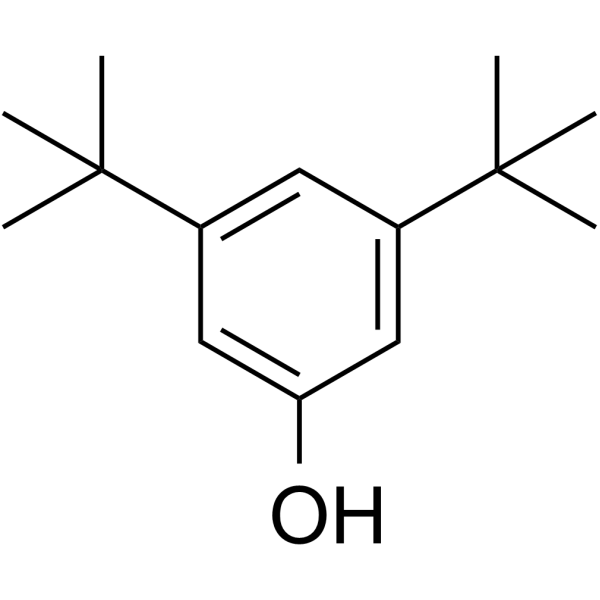Physicochemical Properties
| Molecular Formula | C14H22O |
| Molecular Weight | 206.32 |
| Exact Mass | 206.167 |
| CAS # | 1138-52-9 |
| PubChem CID | 70825 |
| Appearance | Light yellow to light brown solid powder |
| Density | 0.9±0.1 g/cm3 |
| Boiling Point | 276.7±9.0 °C at 760 mmHg |
| Melting Point | 87-89 °C(lit.) |
| Flash Point | 127.2±7.2 °C |
| Vapour Pressure | 0.0±0.6 mmHg at 25°C |
| Index of Refraction | 1.499 |
| LogP | 4.86 |
| Hydrogen Bond Donor Count | 1 |
| Hydrogen Bond Acceptor Count | 1 |
| Rotatable Bond Count | 2 |
| Heavy Atom Count | 15 |
| Complexity | 184 |
| Defined Atom Stereocenter Count | 0 |
| InChi Key | ZDWSNKPLZUXBPE-UHFFFAOYSA-N |
| InChi Code | InChI=1S/C14H22O/c1-13(2,3)10-7-11(14(4,5)6)9-12(15)8-10/h7-9,15H,1-6H3 |
| Chemical Name | 3,5-ditert-butylphenol |
| HS Tariff Code | 2934.99.9001 |
| Storage |
Powder-20°C 3 years 4°C 2 years In solvent -80°C 6 months -20°C 1 month Note: Please store this product in a sealed and protected environment (e.g. under nitrogen), avoid exposure to moisture. |
| Shipping Condition | Room temperature (This product is stable at ambient temperature for a few days during ordinary shipping and time spent in Customs) |
Biological Activity
| References |
[1]. Anti-biofilm mechanisms of 3,5-di-tert-butylphenol against clinically relevant fungal pathogens. Biofouling. 2016 Oct;32(9):979-93. [2]. Characterization of Volatile Organic Compounds Emitted from Endophytic Burkholderia cenocepacia ETR-B22 by SPME-GC-MS and Their Inhibitory Activity against Various Plant Fungal Pathogens. Molecules. 2020 Aug 19;25(17):3765. |
Solubility Data
| Solubility (In Vitro) | DMSO : 100 mg/mL (484.68 mM) |
| Solubility (In Vivo) |
Solubility in Formulation 1: 2.5 mg/mL (12.12 mM) in 10% DMSO + 40% PEG300 + 5% Tween80 + 45% Saline (add these co-solvents sequentially from left to right, and one by one), suspension solution; with sonication. For example, if 1 mL of working solution is to be prepared, you can add 100 μL of 25.0 mg/mL clear DMSO stock solution to 400 μL PEG300 and mix evenly; then add 50 μL Tween-80 to the above solution and mix evenly; then add 450 μL normal saline to adjust the volume to 1 mL. Preparation of saline: Dissolve 0.9 g of sodium chloride in 100 mL ddH₂ O to obtain a clear solution. Solubility in Formulation 2: ≥ 2.5 mg/mL (12.12 mM) (saturation unknown) in 10% DMSO + 90% (20% SBE-β-CD in Saline) (add these co-solvents sequentially from left to right, and one by one), clear solution. For example, if 1 mL of working solution is to be prepared, you can add 100 μL of 25.0 mg/mL clear DMSO stock solution to 900 μL of 20% SBE-β-CD physiological saline solution and mix evenly. Preparation of 20% SBE-β-CD in Saline (4°C,1 week): Dissolve 2 g SBE-β-CD in 10 mL saline to obtain a clear solution. Solubility in Formulation 3: ≥ 2.5 mg/mL (12.12 mM) (saturation unknown) in 10% DMSO + 90% Corn Oil (add these co-solvents sequentially from left to right, and one by one), clear solution. For example, if 1 mL of working solution is to be prepared, you can add 100 μL of 25.0 mg/mL clear DMSO stock solution to 900 μL of corn oil and mix evenly. (Please use freshly prepared in vivo formulations for optimal results.) |
| Preparing Stock Solutions | 1 mg | 5 mg | 10 mg | |
| 1 mM | 4.8468 mL | 24.2342 mL | 48.4684 mL | |
| 5 mM | 0.9694 mL | 4.8468 mL | 9.6937 mL | |
| 10 mM | 0.4847 mL | 2.4234 mL | 4.8468 mL |
